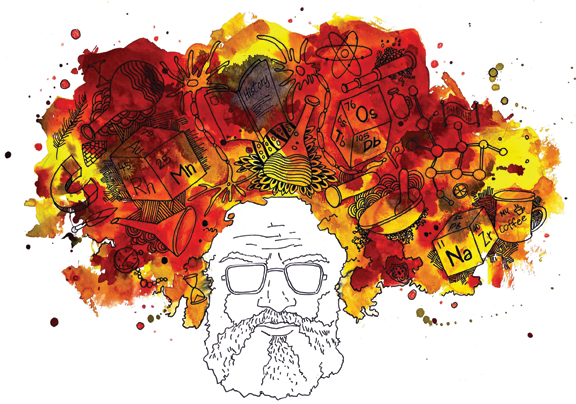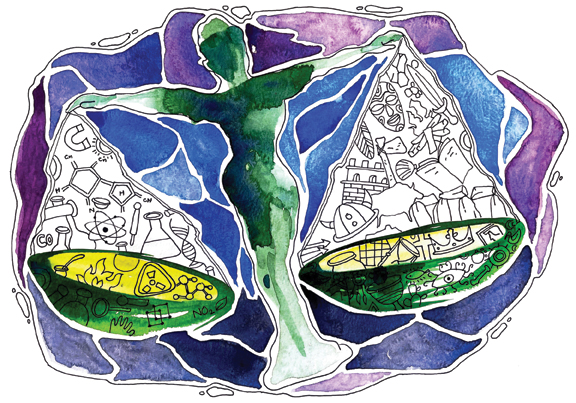Rrishi Raote
On the table next to his bed when Oliver Sacks died were laid out a number of small, cherished objects. Pride of place went to elements of the periodic table, fragments of which Sacks had collected over the years as birthday gifts to himself. Sacks was a neurologist, but his first love had been chemistry. As a child in post-war England, his parents had allowed him to set up a lab in the garden shed – yes, of course there were explosions and you can read all about it in one of Sacks’ memoirs, Uncle Tungsten.
Sacks spoke and wrote of the elements as if they were people, each with its own character and relationships. He also wrote about and saw his patients as people, each normal within their own reality, no matter how peculiar their neurological condition. It’s not surprising that he was effective both as a doctor and as a researcher, nor that he was a wonderful writer (an ability rare among scientists). Here I will suggest that in teaching the history of science, we do as Sacks did in his career in science, which is to bring the human to the centre.

Entry from Wikipedia
Wikipedia’s entries on history of science and related topics are a perfectly good place to start with the following provisos: your students will probably go there too, and perhaps not a lot further; and some key entries, such as “History of Science and Technology in the Indian Subcontinent”, tend to conflate technology and invention with science, when they’re not the same thing.
That said, there have always been intelligent and thoughtful humans. When a technology worked, there was always a theory to explain why it did, and understanding and describing that system of reality is part of the work of history of science. Clearly, the story of science begins in the human mind. With or without a syllabus, Wikipedia can provide a fair overview, but it is only a starting point.
• Is technology science?
• Is science knowledge? Is knowledge science?
Logical and real
Two examples from my school years to show potential and pitfalls. In the 5th standard, the class teacher chose to tell us about the French Revolution. It was presented as a story of fateful steps, one leading inevitably to the next. The ancien régime amounted to a clock spring wound dangerously tight and the weather (i.e., crop failure) was the key that triggered the release of the forces. Events unwound at the speed of catastrophe: action and reaction, until all of a sudden the king was dead, France a republic and Napoleon on the march. Mechanistic, in short. But thrilling, because the imputed logical flow made it easy to memorize and spin out again at will. Plus, it gave a “real” past the urgent feel of current events.
A few years later curriculum was king, and in biology we were taught how systems such as photosynthesis and respiration worked at a chemical level. This was thrilling for a similar reason as the tale from Paris: the satisfyingly complete, step-by-step progression from air+water+sunlight to simple sugars in the plant, and simple sugars to energy in the animal. And this was real too.
It’s a tempting model but this is not how the history of science ought to be taught. For instance, the first example doesn’t ask what was revolutionary about the Revolution (hence, what is a revolution), and the second says nothing about how different biological systems relate to each other (what about proteins and all the complexities they open up). Neither history nor science works like clockwork.
Social science or life science, learning science is thrilling because it can be logical, and thrilling because it is real. How can we harness these two attributes without obscuring complexity? Try: context and biography. Anchor your narrative in the history side of “history of science”.
• Is science good?
• What is a utopia? Why is the ideal presented as the rational? Is the modern constitutional republic a utopia?
Horizontal, vertical and ripples
Then, two obvious approaches recommend themselves. One, to treat each civilization as a unit: the ancient Greek, or Indian or Chinese “contributions” to science. Two, to pick one’s thread vertically: medicine through the ages, or mathematics or chemistry. A lesser way is to look at technologies in use: how was farming done in neolithic Turkey, around ancient Chinese cities, in colonial Haiti, modern Punjab and the Negev; metallurgy from the Bronze Age to the Space Age; medical and military technology of course.
In all cases, information grows so dense during the past five centuries, and particularly the last two, that the categories begin to fray. As a teacher, there’s no point trying to hold the line. So what is to be done? Try setting aside the horizontal perspective (civilization), the vertical (discipline) and the combination thereof (technology through time), and go with ripples!
That is to say, each place and time in its own context with whatever it has to offer.
• Stone, bronze, iron, steel: does hardness matter to history?
• What made a Chinese Chinese, a Greek Greek, an Indian Indian?
Ripple in all directions
In periods of history for which there are few individuated characters, still less individual proto-scientists, we can ask: what does a given technology that we know was in use, make possible? An accurate calendar, predictions of astronomical movements? A well-built granary, a planned street grid, glazed pottery? An enormous temple? Such things speak of surpluses and planning, a centralizing state, a sequence of rituals and the partnering or melding of political and religious authority, the desire for social coherence and a sense of history. How many kinds of specialized work would be required? In such a society, what might be the sciences and who the scientists?
In historical times, your ripples can centre on a person. Why was Socrates sentenced to die? Why didn’t Aristotle do any experiments? Can Kautilya, of the Arthashastra, be called scientific? Did Leonardo da Vinci do science? How come the chemist Robert Boyle was also a theologian, and does it matter that he was born rich? Why was Einstein asked about god? What range of skills did all these thinkers and doers need, and has that changed?

The near-absence of women scientists from history is a lesson in itself; it could be worth observing to what extent the few women scientists of the past led everyday lives different to those of their non-scientific female peers.
• Is a temple good for business? Is business good for science?
• Imagine a stroll through an Indian city in the first millennium. What evidence of science might you see?
Questions and opportunities
Ripples can also centre on an institution, such as the seats of learning in Taxila, Cordoba, Timbuktu, Bologna. Who set up these places and paid their bills? What was taught, who by, and to whom? Was there “research”, and would it count as “science”? What did students do after they “graduated”? If kings and kingdoms don’t last, why did these institutions last?
Contrast the workshop of an early modern alchemist with a modern laboratory. Why do scientists today work in teams? When did science become a profession? How did alchemists share data with each other? What did printing do for thinking?
Linguae francae and globalization offer another set of nice ripples. There’s fun to be had visualizing monks in their scriptoria and the lives of the valuable few polyglots who traversed Greek, Arabic and Latin to recover and extend the scientific thinking of the past. Don’t forget Al-Biruni and his virtuoso study of 11th century North India.
Thus to long-distance travel. What was the social composition of a caravan? How would you stock a wooden sailing ship for hundreds of people for months at sea? What were the diseases of world travel, and how were they explained and treated? If transport was so expensive, how did sugar and slaves make people rich? Was racial thinking scientific?
Travel led to the evolution revolution. How does Darwin’s largely inductivist method differ from the Popperian? Does his theory stand up to modern genetics? (Gregor Mendel’s very followable experiments can feature here.) What kinds of modern science happen outside the lab?
Of course, factories must feature. How did solo inventors enable mass manufacture? What could the individual factory worker expect the boss to do for them and why? When did vaccines become a franchise business and then a factory product?
• Imagine the day of a medieval monk in a scriptorium. What scientific texts might you be copying? How did you manage without eyeglasses?
• Caravan across the Gobi, human mission to Mars: would they be similarly equipped?
The individual as a defence
It’s instructive how the individual scientist as a historical actor appears to diminish in scale the closer our story gets to present times. But as politics make the teaching of history more controversial, there may be some safety in telling the story of science through the lives of scientists and their human historical context. Hopping from ripple to ripple, we need not subject ourselves to the paradigm of “progress” and therefore a weighting of eras and peoples as better or worse, forward or backward. It is not much of a defence, but it may help.
For students, being able to imagine themselves into the strange yet familiar life worlds of real, long-ago thinkers and doers – as Oliver Sacks did lovingly with his patients, research subjects and even some objects that spoke to him of history – may offer the comprehensibility and flavour of the real that make a learning experience cement itself in the mind.
History of science also offers a defence against the silo-ization that everybody decries. It’s one of the few ways we can squeeze into the modern programme of education a reminder that, while we study different subjects in different class periods and with different teachers, textbooks, exams and lingos, all disciplines of study partake of the same moment of historical time that all (or most) of us alive today inhabit, willy-nilly and together. It is, as it should be, a bastion of humanism.
• How many Nobel Prize-winning scientists can you name? Can you describe their work? Why not?
• Use the history function of Google Earth to study your town or region. Use printed maps to go further back in time, where available. How has science changed your surroundings?
The author used to be a features writer and editor for a business newspaper. He studied early modern European history and worked for a short while in academic publishing. He proofs children’s picture books. He can be reached at rraote@yahoo.com.
